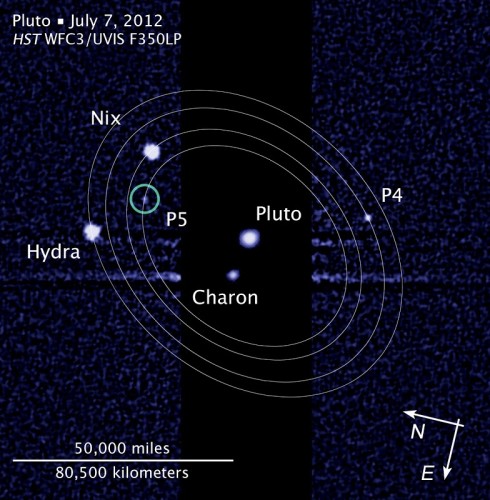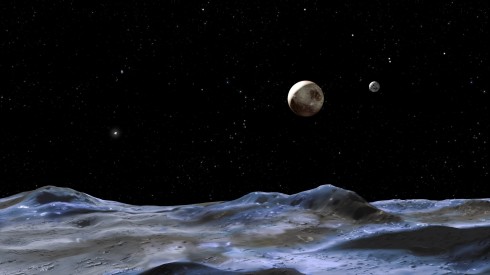Pluto’s new moons named: Spock still homeless


The dwarf planet, Pluto, can still generate plenty of public interest – if the naming of its two recently discovered moons is anything to go by. After their discovery, the leader of the research team, Mark Showalter, called for a public vote to suggest names for the two objects. The on-line contest, aptly named ‘Pluto Rocks!‘, concluded with Vulcan as the outright favorite, after a William Shatner led push by Star Trek fans. The names Cerberus and Styx ranking second and third respectively. The International Astronomical Union (IAU) has announced that the names Kerberos and Styx have officially been recognised for these fourth and fifth moons of Pluto. A decision that is probably correct, even if it proves not to be the most popular.
The moons of Pluto
The new moons were discovered in 2011 and 2012, during observations of the Pluto system made with the NASA/ESA Hubble Space Telescope. Their discovery increasing the number of known Pluto moons to five. Kerberos lies between the orbits of Nix and Hydra, two bigger moons discovered by Hubble in 2005, and Styx lies between Charon, the innermost and biggest moon, and Nix. Both have circular orbits assumed to be in the plane of the other satellites in the system. Kerberos has an estimated diameter of 13 to 34 kilometres, and Styx is thought to be irregular in shape and is 10 to 25 kilometres across.

The recent discoveries of the two small moons orbiting Pluto raise interesting new questions about how the dwarf planet formed. We now know that a total of four outer moons circle around a central “double-planet” comprising Pluto and its large, nearby moon Charon.
No home for Spock
The International Astronomical Union (IAU) is the arbiter of the naming process of celestial bodies, and is advised and supported by astronomers active in different fields. On discovery, astronomical objects receive unambiguous and official catalogue designations. When common names are assigned, the IAU rules ensure that the names work across different languages and cultures in order to support collaborative worldwide research and avoid confusion.
To be consistent with the names of the other Pluto satellites, the names had to be picked from classical European mythology, in particular with reference to the underworld — the realm where the souls of the deceased go in the afterlife. Showalter submitted Vulcan and Cerberus to the IAU where the Working Group for Planetary System Nomenclature (WGPSN) and the Committee on Small Body Nomenclature (WGSBN) discussed the names for approval.
After a final deliberation, the IAU Working Group and Committee agreed to change Cerberus to Kerberos — the Greek spelling of the word, to avoid confusion with an asteroid called 1865 Cerberus. According to mythology, Cerberus was a many-headed dog that guarded the entrance to the underworld. In keeping with the underworld theme the third most popular name was chosen — Styx, the name of the goddess who ruled over the underworld river, also called the Styx.
The IAU decided against the name Vulcan for a number of reasons: Vulcan had already been used for a hypothetical planet between Mercury and the Sun (although this planet was found not to exist), the term “vulcanoid
Orrman-Rossiter K (2013-07-05 00:09:08). Pluto's new moons named: Spock still homeless. Australian Science. Retrieved: Apr 14, 2024, from http://australianscience.com.au/space/plutos-new-moons-named-spock-still-homeless/
 Follow
Follow
Now Showalter has spotted a new moon around Neptune. http://www.wired.com/wiredscience/2013/07/neptunes-new-moon/